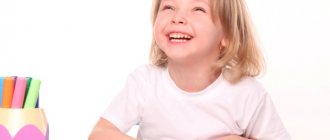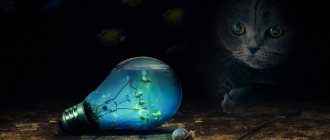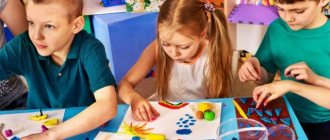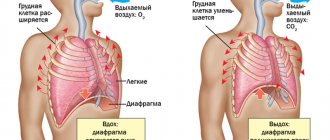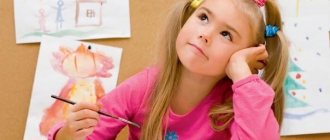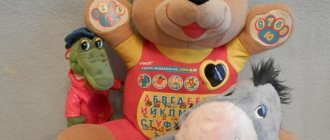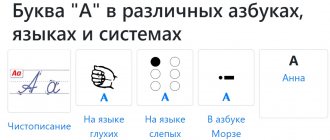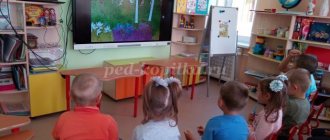What is imagination?
These are not just children's dreams and fables. Imagination is a type of mental activity aimed at processing information and generating new knowledge based on existing images. In other words, a person is forced to rely on memory and logical thinking in order to create an alleged model of something.
Scientists, businessmen, and people of creative professions use imagination. Everyday tasks also require imagination, which is directly related to ingenuity and resourcefulness.
A well-developed imagination makes it easier to communicate with different types of people, helps manage emotions, and build short-term and long-term plans.
Functions of the imagination
Adequate use of imagination allows you to:
- achieve what you want, satisfy needs (use your imagination to conduct thought experiments and choose the best option for the development of events);
- manage time (plan the day, imagining how long each action will take);
- regulate your own mental state (observe others, remember shades of emotions, transfer them to yourself with the help of imagination).
Types of imagination
By intensity:
- active (the brain recreates the image that was previously chosen by the person);
- passive (images appear unconsciously, against the will, reflecting subconscious aspirations).
According to the signs of the occurrence and course of the process:
- uncontrollable (devoid of cause-and-effect relationships, bright, illogical);
- recreating (carrying out operations with the knowledge that has already settled in memory);
- creative (images appear in the mind without relying on experience).
The last type of imagination relies on independent, independent thinking. This is what teachers advise to develop. However, many parents do not fully understand why: “My child does not like creativity, will never be an artist or writer, theoretical knowledge is enough for him.” This approach can ruin the potential that every child has.
Why develop a child's imagination?
The human brain consists of many neurons connected to each other. Their coordinated work solves thousands of small and large problems every day. We regularly need fresh ideas: in kindergarten, school, at work. It is possible to train the brain to produce large volumes of new information at our request.
In childhood, it is easier to accustom yourself to non-standard thinking: the brain is more malleable and plastic, and with the right approach, knowledge is quickly absorbed and consolidated for life.
Since childhood, educators and parents have been concerned about how to develop a child’s memory - quick memorization ensures that the baby will be able to live in a familiar environment without problems and build social connections according to a certain pattern. Imagination has another function: its task is to predict possible scenarios for the development of events in an unstable situation, to predict the future as accurately as possible. This is a kind of adaptation mechanism given by nature.
Newborns have no imagination at all, but curiosity and a thirst for new knowledge are inherent in everyone. Parents should support their child's ideas, even if they seem like stupid fantasies from the experience of an adult.
It is noticeable that not all preschoolers have a developed imagination. However, regular training always gives a positive result - imagination can and should be developed during training.
What influences the development of imagination in children?
Imagination begins to develop under the influence of social factors: upbringing, general education, atmosphere in the house. In order for a child to think productively and freely, it is necessary to accumulate impressions about the world around him. The experience of interacting with people and objects broadens one's horizons and makes the child more erudite. Then the experience gained begins to connect with thinking, guiding the imagination.
For a long time, there was an erroneous point of view that imagination is characteristic only of children, and growing up kills creative impulses and the ability to think freely gives way to a rational, practical view of things. This is wrong. Even mature people have the opportunity to work on their imagination.
We conclude: the passing years are not a hindrance. You can develop your imagination not only in preschool age. Moreover, schoolchildren and adolescents have the advantage of relatively rich life experience and developed abstract thinking.
How does a child’s poor imagination manifest itself?
- Strict adherence to instructions and rules. A preschooler is characterized by disobedience, a desire for independence, and experimentation.
- Loss of initiative. The child does not try to isolate himself from his parents or serve himself independently, because he does not know how to solve emerging problems that require a non-standard approach.
- Isolation, refusal to communicate with peers. The result is poor communication experience, and the breadth of imagination depends on the experience of social interaction.
- Confusion when performing tasks that require a fresh look.
What can become an obstacle to a good imagination?
- Low level of teacher training . Lack of engagement and creativity will lead to weak student skills.
- Parents' disinterest in the child's development . From time to time, children need to be guided, provided with materials for studying, and given tips.
- A team in which a small student is being raised . The environment plays a primary role: if friends do not have motivation and interest in learning about the world, the child will quickly become just as passive.
- Poorly organized regime . Children need regular, vivid impressions that give them qualitatively new sensations. Stability and monotony are the enemies of imagination.
- Nervous situation in the house . Scandals and clarification of relations between parents negatively affect the child’s nervous system. As a result, cognitive abilities deteriorate.
- Health problems . You should undergo medical examinations regularly to know about possible diseases, lack of vitamins, and overwork.
- Personality features . A quiet, insecure child has difficulty establishing contacts with peers and has difficulty adapting to society. It is difficult for him to receive information from other guys.
Mandatory conditions for the creative development of a child
Regularity and systematicity are the main conditions for the creative development of a child, failure to comply with which can negate most of the efforts.
Theater plays an important role in developing imagination
- The development of creative imagination in children of senior preschool age successfully occurs where parents take care of creating a favorable environment for this (that is, where the child is provided with the necessary tools, etc.)
- In order to strengthen a child’s self-esteem and self-confidence, it is important to praise him for any achievements, even those that may not seem significant at first glance.
- A child’s creative imagination is best revealed where the child is given freedom of imagination and is given the opportunity not to be afraid of his creative ideas and ideas.
Development of imagination in preschoolers
When you decide to get serious about working on your child’s imagination, consider his age. The development of imagination is directly related to age. Let's take a closer look at the dependence.
- The baby demonstrates the first rudiments of imagination at an early age (about 2-3 years) . He is interested in stories that adults tell and takes the position of an active observer. Poverty of imagination is evident in the primitive games of young children, which usually consist of several repetitive actions (rolling a ball). Also, children exactly copy the behavior of their elders (putting dolls to bed, feeding them). They are unable to come up with a new element of the game.
- Preschoolers (5-6 years old) demonstrate a high level: when the teacher offers playing conditions, children try to introduce something new into the usual rules. Behavior becomes more complex. The main difference between the imagination of preschoolers is the readiness to operate with distant objects. Kids can only think about what they saw with their own eyes.
Bottom line: younger preschoolers gravitate towards reconstructive imagination, remembering actions and events that left an emotional response. Older preschoolers demonstrate more creative imagination, trying to transform the given things they deal with.
The transition from the first stage to the second occurs through gaming activities. Children always learn through play: they create new plot lines in stories, come up with unusual purposes for things they use every day.
The older the baby gets, the less imaginary images can be connected with reality. You just need to direct your energy and potential in the right direction, paying attention to methods for developing children's imagination.
- Didactic games . They reproduce reality (events, holidays, social roles, household items). It is recommended to choose several types of games: word creation, arrangement of parts in space, abstract games with cards and rules.
- Art . Drawing gives you the chance to bring your wildest ideas to life so that others can look at them and evaluate them from the outside. The child first copies his parents, teachers, and learns to hold a brush or pencil. Then there is an interest in creative self-expression
- Fairy tales . It is no coincidence that they occupy a special place in the folklore of any country: thanks to fairy tales, a person comprehends the culture of the people, develops imagination, inventing unexplored storylines. Fairy tales strengthen emotional intelligence by allowing you to combine typical characters.
- Constructor . When assembling parts into a single whole, the baby is forced to imagine the end result in advance. This is how a preschooler’s spatial thinking is formed and logic develops; the properties of materials and shapes are acquired.
Among the sets of exercises that develop imagination, you can easily find options that suit your family.
- “What does it look like?” Place blots on paper using thread, fingertips, palms, and felt-tip pens. Look at the spots from different angles. The kid needs to figure out what the outlines of the blots look like.
- “Complete the picture” The adult begins to schematically draw an animal or object, then gives the picture to the child, who must guess what is shown on the paper and draw the final lines.
- We write fairy tales ourselves . Parents choose characters by placing them in a fantasy world and inventing obstacles. Then the adult asks the child questions: “What would you do in this situation? Why did the hero do this? What else could he invent? You can tell several alternative endings to the tale.
- Working with cards . The baby is shown cards with simple figures (for example, three yellow circles). You need to fill in the missing details to get a complete image (yellow circle - sun, chamomile, fried egg).
Features of the imagination of preschool children.
Features of the imagination of preschool children.
Content
Introduction
- General characteristics of imagination in human life.
- Types and functions of imagination.
- Techniques for creating imaginative images.
- Peculiarities of children's imagination.
- Ways to improve the imagination of preschoolers.
Conclusion
Practical part
Introduction
In the modern period of development of society, there is a need to form a creatively active personality with the ability to effectively and innovatively solve new life problems. In this regard, preschool institutions face the important task of developing the creative potential of the younger generation. The problem of developing children's imagination is relevant because this mental process is an integral component of any form of child activity, his behavior in general. In recent years, the question has increasingly been raised about the role of imagination in the mental development of a child, about determining the essence of the mechanisms of imagination.
In the studies of L.S. Vygotsky, V.V. Davydova, E.I. Ignatieva, S.L. Rubinshteina, D.B. Elkonina, V.A. Krutetsky and others, imagination is not only a prerequisite for the effective assimilation of new knowledge by children, but is also a condition for the creative transformation of children’s existing knowledge and contributes to the self-development of the individual.
Imagination is the most important aspect of a child's life. It is impossible to master any program without imagination. It is the highest and most necessary ability of a person. At the same time, it is this ability that needs special care in terms of development. Imagination develops especially intensively between the ages of 5 and 15 years. And if the imagination is not specifically developed during this period, then subsequently there will be a rapid decrease in the activity of this function. Along with a decrease in the ability to fantasize, children’s personality becomes impoverished, the possibilities of creative thinking decrease, and interest in art and creative activity fades. In order to develop creative imagination in children, a special organization of visual activities is necessary.
The problem of the study is the development of imagination as the basis for the creative activity of preschool children.
The purpose of the work is to study the possibilities of imagination of preschoolers.
The object of the study is the development of imagination in preschool children.
The subject of the study is the features of the development of creative imagination in preschool children.
To achieve this goal, it is necessary to solve the following tasks:
. Reveal the features of imagination in preschool children;
. Conduct diagnostics of the imagination of preschool children;
. Determine possible ways of developing imagination in preschool children;
- General characteristics of imagination in human life.
Imagination is a special form of the human psyche, standing apart from other mental processes and at the same time occupying an intermediate position between perception, thinking and memory.
Imagination is a mental process consisting of the creation of new images (ideas) by processing the material of perception and ideas obtained in previous experience.
The specificity of this form of mental process is that imagination is probably characteristic only of humans and is strangely connected with the activities of the body, being at the same time the most “mental” of all mental processes and states (since in no way other than the imagination, the ideal and mysterious character of the psyche does not manifest itself). It can be assumed that it was imagination, the desire to understand and explain it, that attracted attention to psychic phenomena in ancient times, supported and continues to stimulate it in the present day.
The mystery of this phenomenon: until now we know almost nothing about the mechanism of imagination, about its anatomical and physiological basis. Where is imagination located in the human brain? With the work of which nervous organic structures known to us is it connected? We cannot answer these important questions with almost anything concrete. In any case, we can say much less about this than, for example, about sensations, perception, attention, memory, etc.
Imagination is of great importance in a person’s life; it affects his mental processes and states, and even the body. Thanks to imagination, a person creates, intelligently plans and manages his activities. Almost all human material and spiritual culture is a product of people's imagination and creativity. Imagination takes a person beyond his immediate existence, reminds him of the past, and opens up the future. Possessing a rich imagination, a person can “live” at different times, which no other living creature in the world can afford. The past is recorded in memory images, arbitrarily resurrected by an effort of will, the future is presented in dreams and fantasies.
Imagination is the basis of visual-figurative thinking, which allows a person to navigate a situation and solve problems without the direct intervention of practical actions. It helps him a lot in those cases of life when practical actions are either impossible, or difficult, or simply impractical.
Imagination differs from perception in that its images do not always correspond to reality; they contain elements of fantasy and fiction. If the imagination draws to consciousness such pictures that nothing or little corresponds in reality, then it is called fantasy. If, in addition, the imagination is aimed at the future, it is called a dream.
- Types and functions of imagination.
In humans, the following main types of imagination are distinguished: active and passive, productive and reproductive. Separately, such types of imagination as dreams, hallucinations, daydreams and daydreams are identified and considered.
Active is the imagination, the images of which are born and changed with the participation of the human will. Using this type of imagination, a person consciously sets himself the task of inventing something and then fulfills it. This type of imagination is called active because at any moment in time, creating an appropriate image, a person can introduce something new, stop, that is, he is able to control this process or stop it of his own free will.
Passive is an imagination in which images are born and change spontaneously, without the participation of human will. In this case, he is not able to control either the beginning, the course, or the end of the corresponding process. Examples of passive imagination are hallucinations and dreams.
Productive is called imagination, in the images of which there are many new things (elements of fantasy). The products of such imagination are usually similar to nothing or very little similar to what is already known (the creation of new literary works or works of art).
Reproductive is an imagination, the products of which contain a lot of what is already known, although there are also individual elements of the new. (the imagination of an aspiring poet, writer, engineer, artist, who at first create their creations based on well-known images and motifs, learning professional skills).
According to the degree of activity and awareness of a person’s creation of new images, imagination can be involuntary (passive) and voluntary (active
).
In involuntary,
new images arise under the influence of little-conscious or unconscious needs, drives and attitudes.
Such imagination works, as a rule, when a person is sleeping, in a drowsy state, in dreams, etc. Voluntary
imagination is the process of deliberately constructing images in connection with a consciously set goal in a particular activity. This type of imagination is characterized by awareness of not only the goal, but also the motives of activity, an understanding of why new images are produced. Voluntary imagination arises at an early age, and is most developed in children's games.
According to the degree of uniqueness, imagination is divided into recreative (reproductive) and creative.
Recreating Imagination
characterized by the fact that in its process subjectively new images are created, i.e.
images that are new for a given individual, which objectively already exist in certain cultural objects. Reconstruction of an image can occur on the basis of a verbal description, perception of images in the form of pictures, diagrams, etc. Recreative imagination plays an important role in human life. It allows people to share experiences and helps each person to master the achievements of other people. Creative imagination
is the independent creation of new images that are realized in original products of activity. This is the production of an original image without relying on a ready-made or conditional description. This type of imagination plays an important role in all types of creative activity.
In human life, imagination performs several different functions.
.
The first of them is to, imagining what does not exist in reality, creatively transform
the world around us, creating something new from the products of our imagination. Thanks to the imagination of representatives of creative professions, over the millennia of human existence, a new world was created - the world of human material and spiritual culture.
The second function of imagination is associated with self-regulation of behavior
,
mental processes and human states.
In order to influence his behavior in the future, a person plans it and plays it out in his imagination. This is what every person does, concerned that, by behaving in a certain way, he will achieve his goal in the future. This same function of imagination is widely used in many modern methods of psychotherapy, where through a person’s voluntary imagination a certain psychotherapeutic influence is exerted on him. Finally, through his imagination, a person can influence his own perception, memory, thinking, speech and other mental processes.
The third function of the imagination is to form with its help an internal plan of action,
that is, the ability to perform actions in the mind while manipulating images. For example, a child who has learned to solve problems by acting with real material objects, at the next stage of the development of his thinking can learn to solve problems by acting in his mind only with images of the corresponding objects. This function of imagination is most fully realized in human visual and figurative thinking and in its development. In its elementary form, this type of thinking is found in preschool children, and in more complex forms - in adults who, due to the nature of their professional activities, have to solve rather complex problems with the help of imaginative thinking. These are, for example, designers and artists, writers and actors, politicians and engineers.
The fourth function of imagination is programming
future human behavior. It is realized in a person’s mental drawing up of plans and programs for his future behavior, in their figurative representation.
The fifth function of imagination can be designated as psychodiagnostic.
It lies in the fact that from the products of a person’s imagination one can draw certain conclusions about his own psychology. This function is widely used, for example, in many modern psychodiagnostic tests, where, as a result of analyzing the products of a person’s imagination, his psychology is judged. Such tests are called projective. We use the same function every day when we judge the psychology of another person by the products of his fantasies. This function is sometimes used by psychiatrists to make a diagnosis in absentia based on the products of a person’s imagination.
1.3 Techniques for creating images of the imagination.
A number of techniques are used to create new and transform existing images in the imagination. These include primarily the combination
- a combination of individual elements of various images of objects in new, more or less unusual combinations.
A special case of combination is agglutination
- the creation of new images based on the “gluing together” of ideas that are incompatible in everyday life.
On the basis of agglutination, mythological images of a centaur, Minotaur, Pegasus, a fairy-tale image of a mermaid, etc. were created. Another technique of imagination is accentuation
- emphasizing certain features.
This is carried out on the basis of highlighting, abstracting and transforming the essential features of an object or phenomenon. The technique of accentuation is expressed, for example, in highlighting certain features in cartoons or caricatures. Close to agglutination as a form of transformation of the representation of hyperbolization
, which is characterized not only by an increase or decrease in the object (a giant is as huge as a mountain and a boy as big as a finger), but also by a change in the number of parts of the object or their displacement: multi-armed goddesses in Indian mythology, dragons with seven heads, etc. .d.
A special form of imagination is
dream. It is always directed towards the future. A dream allows a person to outline the future and organize behavior for its implementation. The images that a person creates in his dreams are distinguished by their bright, lively, concrete character and emotional richness, attractiveness for the subject. However, dreams are only useful when they connect the desired future with the present. If there is no such connection, then from a stimulus for action the dream can turn into a daydream, an unreal dream.
Fantasy seems to be a necessary element of scientific and artistic creativity. In fantasy, new images are constructed, often far from real images. Fantastic images serve to find a figurative explanation for incomprehensible phenomena and fill the information gap. Often in psychology the terms “imagination” and “fantasy” are equated.
- Peculiarities of children's imagination.
The majority of researchers note that the formation of a child’s personality begins in the preschool period. Children experience such personal developments as the subordination of motives, the assimilation of moral norms, and the formation of arbitrary behavior.
A child in preschool age begins to realize and generalize his experiences, an internal social position is formed, a more stable self-esteem and a corresponding attitude towards success and failure in activities.
At preschool age, the child is psychologically separated from close adults with whom he was previously inextricably linked, and is opposed to them in everything. The child’s own “I” moves away from adults and becomes the subject of his experiences. The feeling “I myself”, “I want”, “I can” appears. It is characteristic that it is during this period that many children begin to use the pronoun “I” (before this they spoke about themselves in the third person).
The child’s own “I” can stand out and be recognized only by pushing away and opposing another “I” that is different from his own. Separation and alienation of oneself from an adult leads to the fact that the child begins to see and perceive the adult differently. Previously, the child was primarily interested in objects; he himself was directly absorbed in his objective actions and seemed to coincide with them. All his affects and activities lay precisely in this area. Objective actions covered the figure of the adult and the child’s own “I”. With the separation of oneself from one's action and from the adult, a new discovery of oneself and the adult occurs. Adults, with their attitude towards the child, seem to appear for the first time in the inner world of a child’s life. From a world limited by objects, the child moves into the world of adults, where his “I” takes a new place. Having separated from the adult, he enters into a new relationship with him.
There are two sides to the development of a child’s personality. Firstly, the child gradually begins to understand the world around him and realizes his place in it. This, in turn, gives rise to new types of behavioral motives, under the influence of which the child commits certain actions. Secondly, there is a development of feeling and will. They ensure the effectiveness of these motives, the stability of behavior, and its certain independence from changes in external circumstances.
Preschool age plays a special role in the mental development of a child: during this period of life, new psychological mechanisms of activity and behavior begin to form.
This age brings the child new fundamental achievements. One of the most important achievements of senior preschool age is the awareness of one’s social “I”, the formation of an internal social position and ideas about oneself.
At preschool age, the content of a child’s self-image includes a reflection of his properties, qualities, and capabilities. Data about one’s capabilities accumulates gradually through the experience of various activities and communication with adults and peers. The child’s ideas about himself are supplemented by an appropriate attitude towards himself.
In preschool age, the child develops an image of himself by establishing connections between the child’s individual experience and the information he receives in the process of communication. By establishing contacts with people, comparing himself with them, comparing the results of his activities with the results of other children, the child gains new knowledge not only about the other person, but also about himself.
To develop independence in behavior (and in reasoning), a child must learn in each specific case to highlight the most important, essential and understand what is most important. But this is not immediately given to children. Although a preschooler can be guided by various motives known to him: in particular, responsibilities, instructions from his mother, his own desire or feeling for a friend, he does not yet have the usual subordination of all motives, their hierarchy. Therefore, a five- or six-year-old child often finds himself in conflict situations. And they most often obey the impulse that is emotionally strongest and most vivid.
It should be noted that creative imagination depends on many factors:
1. Age.
2. Mental development and developmental characteristics (presence of any disorder of psychophysical development).
3. Individual personality characteristics (stability, awareness and direction of motives; evaluative structures of the image of “I”; communication features; degree of self-realization and assessment of one’s own activities; character traits and temperament).
4. Development of the process of training and education.
A child’s experience develops and grows gradually; it is deeply unique compared to the experience of an adult. The child’s attitude to the environment, which with its complexity or simplicity, its traditions and influences stimulates and directs the creative process, is again completely different. The interests of a child and an adult are different and therefore it is clear that a child’s imagination works differently than an adult’s.
A child's imagination is poorer than an adult's. At the same time, there is still an opinion that a child has a richer imagination than an adult. The child lives in a fantasy world more than in the real one. At the same time, the child’s interests are simpler, more elementary, poorer, and finally, his relationship with the environment also does not have the complexity, subtlety and diversity that mark the behavior of an adult, and these are all the most important factors that determine the work of the imagination. As a child develops, his imagination also develops. That is why the products of real creative imagination in all areas of creative activity belong only to already mature imagination.
French psychologist T. Ribot presented the basic law of imagination development in three stages:
1
Childhood and adolescence are the reign of fantasy, games, fairy tales, and fiction.
2
Youth is a combination of fiction and activity, “sober, calculating reason.”
3
Maturity is the subordination of the imagination to the mind and intellect.
A child’s imagination begins to develop quite early; it is weaker than that of an adult, but it occupies more space in his life.
Until the age of 3, children’s imagination exists within other mental processes, where its foundation is laid. At the age of three, the formation of verbal forms of imagination occurs. Here imagination becomes an independent process.
At 4–5 years old, the child begins to plan, to make a mental plan for upcoming actions.
At 6-7 years old, the imagination is active. Recreated images appear in various situations, characterized by content and specificity. Elements of creativity appear.
Therefore, imagination plays an important role in human life. According to a number of researchers, it is thanks to imagination that people are able to create new things because as soon as in the process of imagination a person cannot count in advance on the result that he hopes to obtain.
- Ways to improve the imagination of preschoolers.
The emergence and development of imagination is a socially determined process. It is the adult who lays down the mechanisms of imagination in the child.
For preschoolers, play activities are a powerful stimulus for the imagination. Playing a role and developing the plot encourage the child to recombine known events, create new ones, and complement his own impressions. While transforming into different characters, the child has the opportunity to look at the situation from different angles.
In the child’s object environment there should be not only familiar objects with fixed functions, but also non-specific, semi-functional objects - waste material, which includes boxes, spools, scraps of fabric, paper and natural material (cones, twigs, acorns). Playing with such objects plays an important role in the development of imagination in preschoolers. By acting with them, giving them different meanings in different situations, the child actively learns substitution. It is also necessary to remember that the development of imagination is closely related to the mastery of the laws of the native language. It is the word that allows the child to imagine and transform an object in its absence.
The preschooler’s own experience and rich ideas create the basis for imagination. That is why the main task of an adult is to teach the child the ways and means of transformation, to develop his combinatorial abilities. It will also teach the child to formulate plans of varying degrees of complexity and implement them primarily in productive activities.
Leadership imagination requires an adult to create problem situations that do not have a clear solution and situations where solutions are not defined. E.E. Kravtsova showed how the position of an adult changes in communication with a child in order to develop imagination. In early preschool age, it is more correct to take the position of the ignorant, the inept, in order to show, with the help of remarks and questions to the child, that the same situation can have several solutions. By the age of 4-5 years, competition with peers, led by an adult, becomes the incentive: “Who can come up with a more interesting idea?”, “Who can come up with a different idea than a friend’s?” But for older preschoolers, conditions should be created so that he himself would take a teaching position, especially in relation to younger children, telling them fairy tales, organizing games, and showing dramatizations.
Conclusion
Under existing conditions, it is necessary to carry out special work in kindergartens aimed at developing the creative imagination of children, especially since preschool age is a sensitive period for the development of this process.
You can develop creative imagination not only in special classes. Play, which is the main activity of preschoolers, is of great importance for the development of children’s imagination. It is in play that the child takes the first steps of creative activity. Adults should not just observe children's play, but manage its development, enrich it, and include creative elements in the game. At an early stage, children's games are objective in nature, that is, they are actions with various objects. At this stage, it is very important to teach the child to play with the same subject in different ways. For example, a cube can be a table, a chair, a piece of meat, etc. Adults should show children the possibility of different ways to use the same objects. In addition, to develop imagination and creativity, there are special games that you can play with children in your free time.
The richest source for the development of a child’s imagination is a fairy tale. There are many techniques for working with fairy tales that educators can use to develop children's imagination. Among them: “twisting” a fairy tale, inventing a fairy tale in reverse, inventing a continuation of a fairy tale, changing the end of a fairy tale. You can write fairy tales with your children.
An integrated approach to developing the imagination of preschoolers through visual activities helps to increase imagination levels.
Bibliography
- Borovik O. V. Development of imagination. Guidelines. – M.: LLC “TsGL “Ron”” 2000.
- Nemov R.S. Psychology: Textbook for students of higher pedagogical educational institutions: In 3 books. – 4e. edition - M.: Humanitarian Publishing Center Vlados, 2001.
- Dyachenko O. M. On the main directions of development of imagination in children. // Questions of psychology. 1988.
- Korshunova L. S. Imagination and its role in cognition. – M., 1979.
- Subbotina L. Yu. Development of children's imagination. A popular guide for parents and teachers / Artist V. N. Kurov – Yaroslavl: “Academy of Development”, 1997.
Practical part
Tasks:
1. identify the features of imagination using the material of creative storytelling.
2. determine subsequent work on the development of imagination.
Methodology.
Stimulus material: 2-3 subject pictures or postcards with images of animals.
Stage 1 of the study.
Invite your child to come up with fairy tales “Who builds a house?” (Fox and squirrel). Annex 1
- stage.
Invite the child to continue the fairy tale started by the teacher, “The Good Bear.” (In a small forest, at the edge of a large spruce tree, there was a large den. A huge but very kind bear lived in it. Every morning he went into the very thicket of the forest and picked the reddest raspberries there. And then one day......)
- stage.
Come up with a fairy tale with certain characters. They post a picture and suggest: “Create a fairy tale with these animals.” Appendix 2
Analysis of results.
1. Determine the plot of a fairy tale: everyday, fairy tale, adventure.
The plot is based on the fairy tale “Who builds a house?” - household.
The plot of the fairy tale “The Good Bear” is an adventure.
The plot of the fairy tale “Beasts in the Magic Forest” is fabulous.
2. The number of storylines, their relationships (the variety of storylines indicates that the child can imaginatively move away from reality and foresee the development of the plot).
Observing the children tested, it should be noted that each has a different number of storylines, which indicates a fairly well-developed imagination. But of course there were children whose imagination was less developed. As a rule, these are unsociable children.
3. The composition of a fairy tale: the presence of a beginning, plot, plot development, climax, denouement and ending, logical completeness confirms the understanding and establishment of the relationship between imaginary events and reality.
4. The number of main and secondary characters, the degree of development of their characteristics spoke about the depth of children’s penetration into the plot.
5. Children describe the appearance of the characters, their spiritual qualities, places of action, using the information received during a number of classes during their education at a preschool educational institution; many children receive information from books from their parents.
6. Emotionality of the description: they use evaluative judgments such as: beautiful, bad, fluffy and the corresponding suffixes or include themselves as a character, emotionally characterize, are active in the process of creating images.
7. The presence of an idea for a fairy tale: the children clearly formulated the fairy tale, which indicates the consciousness of the idea.
8. The plot of the fairy tale for children was connected with their experience and acquired knowledge, which indicates the connection between the child’s imagination and reality.
9. General conclusion: children participate with pleasure in the process of composing fairy tales, emotionally express their attitude towards the main and secondary characters, give detailed answers to the teacher’s questions to continue the plot, and actively tell stories.
Didactic games to develop the imagination of preschoolers
"Nonexistent Animal"
Goal: to develop children's creative imagination.
Progress of the game: If the existence of a hammerhead fish or a needle fish is scientifically proven, then the existence of a thimble fish is not excluded. Let the child fantasize: “What does a panfish look like?” What does a scissor fish eat and how can a magnet fish be used? "
"Make up a story"
Goal: to develop children's creative imagination.
Progress of the game: invite children to look at the pictures in the book and invite them to come up with new events together.
"Continue drawing"
Goal: to develop children's imagination and fine motor skills.
Progress of the game: a simple figure (a figure eight, two parallel lines, a square, triangles standing on top of each other) must be turned into part of a more complex pattern. For example, from a circle you can draw a face, a ball, a car wheel, or glasses. It is better to draw (or offer) options one by one. Who is bigger?
"Blot"
Goal: to develop children's creative imagination.
Material: sheets of paper with blots on them.
Progress of the game: the famous Rorschach test is built on this principle.
Children must figure out what the blot looks like and finish drawing it. The one who names the most items wins.
"Revitalization of objects"
Goal: to develop children's creative imagination.
Progress of the game: imagine yourself as a new fur coat; lost mitten; a mitten that was returned to the owner; a shirt thrown on the floor; shirt, neatly folded.
Imagine: the belt is a snake, and the fur mitten is a mouse. What will be your actions?
“It doesn’t happen like that! »
Goal: to develop children's creative imagination.
Progress of the game: the participants in the game take turns telling some incredible story, short or long. The winner is the player who manages to come up with five stories, upon hearing which the listeners will exclaim: “That doesn’t happen!” "
"Draw the mood"
Goal: to develop children's creative imagination.
Material: paper, watercolor paints
Progress of the game: This game can be used if the child is in a sad mood or, conversely, very cheerful, as well as some other, the main thing is that he is in some kind of mood. The child is asked to draw his mood, depict it on paper in any way.
Annex 1
Appendix 2
